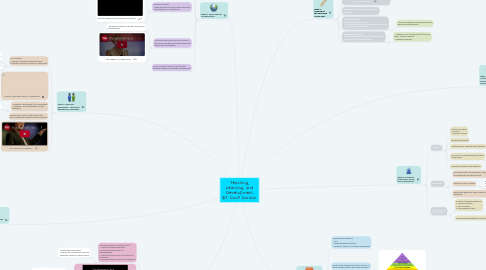
1. Week 5: Making Instructional Decisions
1.1. Universal Design for Learning (UDL) - 3 primary guiding principles: 1. Provide multiple means of representation 2. Provide multiple means of action and expression 3. Provide multiple means of engagement
1.1.1. - Engage the disengaged - Support and challenge all learners - Effective classroom environment
1.2. Zoe Branigan-Pipe: Letting Students Hack Their Lesson Plan
1.2.1. - Open, student-centered, no secrets
1.2.2. - Students feel valued
1.2.3. - Students can visually see what they need to learn and why certain topics are being taught (because it is in the curriculum!)
1.3. Bloom's Taxonomy (6 levels), Stiggin's Targets
1.4. Playing and learning go hand-in-hand
1.5. - Direct instruction - Inquiry-based learning - Problem-based learning
2. Week 6: Knowing That the Students Know
2.1. Assessment guides instruction - educators must be cognizant of the varying ways students learn and show their learning
2.1.1. Gardner's Theory of Multiple Intelligences
2.1.2. How People Learn Framework
2.2. Cultural Shift - Teacher as judge --> Teacher as coach - Grading culture --> Learning culture
2.3. "If we plant lettuce and it doesn't grow, we don't blame the lettuce. We look for reasons why it isn't doing well."
2.4. Backward Design: what should students be able to do at the end of the unit/course
2.4.1. - This is how you plan!
3. Week 7: Individual Differences - Intellectual Abilities and Challenges
3.1. Full Inclusion - Range of abilities and development (cognitive, physical, emotional, and social)
3.1.1. Is a full inclusionary approach the most effective way to ensure ALL students are successful?
3.1.2. Trifecta: school, systems, and community supports
3.2. Carroll's Hierarchial Model of Intelligence
3.2.1. - There are different methods for measuring intelligence
3.3. - Disability: the inability to do something - Handicap: a disadvantage in certain situations
3.3.1. *PEOPLE-FIRST LANGUAGE
3.4. Change the school so the student fits, don't change the student so the school fits
3.5. Do Schools Kill Creativity?
4. Week 8: Socio-Cultural Considerations
4.1. Equality vs. Equity
4.2. All children can learn - including all abilities, ethnic groups, sizes, ages, backgrounds, races, religions, and genders
4.2.1. Change the system to fit the child!
4.3. Increase Diversity - what does this look like in the classroom? - individualism vs. collectivism
4.3.1. Culturally Responsive Teaching and Learning
4.4. Culturally Responsive Practice: a brood cultural knowledge and instructional base that grows and changes
4.4.1. - Educators must be cognizant of personal beliefs/values
4.4.2. The Danger of a Single Story
4.5. Socio-economic status (SES) has the greatest impact on scholastic achievement
5. Week 1: Planning for the Upcoming School Year
5.1. What is School For?
5.2. Intentional curriculum and instructional planning
5.3. Reflective Practice 1. Apply what research says 2. Evaluate effectiveness of research propositions 3. Use scholarly knowledge
5.3.1. - Be open-minded, use different cultural lenses and perspectives
5.4. Educational Psychology - understanding human behaviours involved in teaching and learning processes
5.4.1. - Schwab's Four Commonplaces (teacher, topic, setting, student) - Research methods
6. Week 2: Considering Developmental Differences
6.1. What Adults Can Learn From Kids
6.1.1. - Bi-directional teaching
6.1.2. - Don't underestimate kids, they are beyond capable more than we can merely imagine
6.2. Growth Mindset - Intelligence can be learned
6.2.1. - positivity and reinforcement - the power of "yet"
6.3. Each student, teacher, administrator, parent, person is UNIQUE
6.3.1. - Differentiated Instruction
6.3.2. - Individual development and the brain
6.4. Piaget, Vygotsky
6.4.1. - Constructivist - Zone of Proximal Development - Scaffolding
7. Week 3: Cognitive, Behavioural, Social, and Constructivist
7.1. Cognitive
7.1.1. Mental Processes: - Memory - Problem Solving
7.1.2. Dominant approach
7.1.3. Metacognition: thinking about thinking
7.1.4. Focuses on understanding and logical connections
7.1.4.1. April, August, December, February, July, June, March, May, November, October, September
7.1.5. Language, thought, and creativity
7.2. Behaviourist
7.2.1. Main assumption: all behaviour is learned and shaped by the environment
7.2.2. Bandura, Pavlolv, Skinner
7.2.2.1. Bobo doll, classical conditioning (learning behaviours), operant conditioning (behaviour consequences)
7.2.3. Observable behaviour can be objectively measured
7.3. Social Cultural/ Constructivist
7.3.1. 3 factors influence behaviour: 1. The environment 2. The individual 3. The behaviour itself
7.3.2. Are we setting students up for success?
7.3.2.1. - student-centered, learner-constructed
7.3.2.2. - self-determination, self-regulation
8. Week 4: Establishing a Positive Learning Environment
8.1. Individualized Learning - IEPs - Differentiated instruction - Gardner's Theory of Multiple Intelligences
8.2. What do the students need to succeed, vs. what do they want to help them succeed
8.2.1. Maslow's Hierarchy of Needs
8.3. The Myth of Average: Todd Rose
8.3.1. The cock-pit analogy: there is NO average, so ban the idea of an average in the classroom

